Dynamic Landslide Susceptibility Assessment in the Yalong River Alpine Gorge Region Integrating InSAR-Derived Deformation Velocity
Highlights
- Quantifies deformation velocity as the second critical susceptibility factor (q = 0.21), enhancing spatial risk clustering characterization.
- Achieves significant predictive gains (AUC = 0.9798, Kappa = 0.8870, 87.01% high-risk capture rate).
- Provides a real-time early warning tool for landslides in high-risk terrains.
- Validates deformation velocity as a measurable indicator for prioritizing geotechnical interventions.
Abstract
1. Introduction
2. Study Area and Datasets
2.1. Study Area
2.2. InSAR Data Sources
2.3. Landslide Conditioning Factors
- Topographic Factors: Slope, Aspect, Relief Amplitude, Plan Curvature, and Profile Curvature. These factors govern overland flow convergence, mass wasting potential, and gravitational stress accumulation, exerting direct control over the spatial distribution of landslides.
- Hydrometeorological Factors: Annual Precipitation, Stream Power Index (SPI), Topographic Wetness Index (TWI), and Distance from Rivers. These capture hydrodynamic processes and represent primary external triggers, particularly for rainfall-induced failures.
- Plant and Soil Factors: Normalized Difference Vegetation Index (NDVI), Plant Types, Soil Types, and Soil Erosion Types. These modulate surface stability through runoff/erosion control and critically influence shallow landslide potential.
- Geological Factors: Lithology and Distance from Faults. These determine rock/soil strength characteristics and structural fragmentation, constituting intrinsic controls on material stability.
- Engineering Disturbance and Surface Deformation: Land Cover, Distance from Roads, and SBAS-InSAR-derived Deformation Velocity. Anthropogenic slope modifications such as road construction and excavation can induce mechanical instability, while surface deformation monitoring facilitates early identification of active or incipient slope failures.
3. Methodology
3.1. Time-Series InSAR Surface Deformation Monitoring Method
- Spatiotemporal Baseline Thresholding: Define temporal and perpendicular baseline thresholds to select interferometric pairs with high coherence.
- Image Co-Registration: Achieve pixel-level alignment for all selected pairs to ensure phase accuracy.
- Phase Unwrapping: Retrieve absolute phase values from wrapped interferograms by resolving the 2π ambiguity. A coherence threshold of 0.1 was applied to select reliable pixels for unwrapping and subsequent time-series analysis.
- Residual Phase Removal: Non-deformation components—including orbital errors, atmospheric delays, and DEM residuals—were mitigated. Precise Orbit Ephemerides from the European Space Agency (ESA) were incorporated to enhance orbital accuracy. For atmospheric correction, the method proposed by [57] was employed due to its efficacy in topographically complex regions, outperforming generic models in reducing topography-correlated atmospheric delays.
- Reference Frame: The reference point was automatically established by the software based on the average elevation of the input SRTM 1-arc-second DEM across the entire scene, ensuring a stable and unbiased reference.
- Deformation Time-Series Inversion: Establish linear equations across interferometric pairs and apply Singular Value Decomposition (SVD) to stably invert displacement values at each epoch.
- Geocoding: The final deformation results in radar coordinates were transformed into geographic coordinates with a spatial resolution of approximately 15 m, ready for GIS integration.
3.2. Slope Unit Delineation
3.3. Factor Selection
3.3.1. Pearson Linear Correlation Analysis
3.3.2. Multicollinearity Testing-VIF/TOL
3.3.3. Dominant Factor Identification Via Factor Detector
3.4. Susceptibility Model Construction
3.5. Accuracy Assessment
4. Results
4.1. Surface Deformation Results from SBAS-InSAR
4.2. Slope Unit Delineation Results
- −43 to −25 mm/a
- −25 to −7 mm/a
- −7 to 7 mm/a
- 7 to 25 mm/a
- 25 to 39 mm/a
4.3. Model Comparison Results
5. Discussion
5.1. Analysis of Factor Contributions
5.2. Applicability Analysis
6. Conclusions
- (1)
- A geodetector–random forest evaluation framework integrated with time-series InSAR monitoring was developed and applied to the Xinlong–Kangding section of the Yalong River Basin. Based on Sentinel-1 imagery acquired from 2020 to 2023, surface deformation velocities were derived using the SBAS-InSAR technique. The results identified 24 highly active landslide areas exhibiting annual average deformation velocity exceeding 25 mm/a.
- (2)
- By integrating InSAR-derived deformation data with historical landslide distributions, the delineation of slope units was optimized to construct a high-quality sample set for comparative experiments. The results demonstrate that the inclusion of deformation factors significantly enhances the model’s discriminative performance, with the AUC value increasing to 0.9798 and the Kappa coefficient rising to 0.8870. Additionally, the landslide containment rate in the Very High susceptibility class improved from 67.21% to 87.01%, a gain which we attribute to the way deformation velocity identifies and differentiates slopes exhibiting recent movement activity from those that are stable (particularly among areas with similar geological-geomorphological characteristics) and synergizes with static factors to better characterize spatial clustering patterns, particularly in response to recent triggering events. These findings confirm the efficacy of multi-source data integration in improving landslide susceptibility assessments in alpine canyon environments, and underscore its advantage in capturing spatially clustered landslide hazards.
- (3)
- Geodetector-based interaction analysis reveals that the nonlinear coupling between annual precipitation and soil type (q = 0.38) predominantly controls shallow landslide initiation, exhibiting a 15% improvement in explanatory power compared to individual factors. In contrast, terrain-related variables such as the Topographic Wetness Index (TWI) and distance to roads influence slope stability Via coupled effects from anthropogenic slope modifications and hydrological concentration, exhibiting a quasi-linear enhancement effect (q = 0.21). These spatial interaction patterns are corroborated by SHAP analysis, which highlights a distinctive contrast between spatially clustered hazards and distributed stabilizing factors, providing robust quantitative evidence for the compound, multi-source nature of landslide susceptibility differentiation.
Author Contributions
Funding
Data Availability Statement
Conflicts of Interest
Correction Statement
References
- Kirschbaum, D.B.; Adler, R.; Hong, Y.; Hill, S.; Lerner-Lam, A. A Global Landslide Catalog for Hazard Applications: Method, Results, and Limitations. Nat. Hazards 2010, 52, 561–575. [Google Scholar] [CrossRef]
- Petley, D. Global Patterns of Loss of Life from Landslides. Geology 2012, 40, 927–930. [Google Scholar] [CrossRef]
- Li, Y.; Chen, J.; Zhou, F.; Song, S.; Zhang, Y.; Gu, F.; Cao, C. Identification of Ancient River-Blocking Events and Analysis of the Mechanisms for the Formation of Landslide Dams in the Suwalong Section of the Upper Jinsha River, SE Tibetan Plateau. Geomorphology 2020, 368, 107351. [Google Scholar] [CrossRef]
- Pan, G.; Wang, L.; Li, R.; Yuan, S.; Ji, W.; Yin, F.; Zhang, W.; Wang, B. Tectonic Evolution of the Qinghai-Tibet Plateau. J. Asian Earth Sci. 2012, 53, 3–14. [Google Scholar] [CrossRef]
- Zhang, J.; Yang, R.; Qi, Y.; Zhang, H.; Zhang, J.; Guo, Q.; Ma, C.; Wang, H. A Study on the Monitoring of Landslide Deformation Disasters in Wenxian County, Longnan City Based on Different Time-Series InSAR Techniques. Nat. Hazard. 2024, 120, 11851–11875. [Google Scholar] [CrossRef]
- Guzzetti, F.; Peruccacci, S.; Rossi, M.; Stark, C.P. The Rainfall Intensity–Duration Control of Shallow Landslides and Debris Flows: An Update. Landslides 2008, 5, 3–17. [Google Scholar] [CrossRef]
- Kirschbaum, D.; Kapnick, S.B.; Stanley, T.; Pascale, S. Changes in Extreme Precipitation and Landslides Over High Mountain Asia. Geophys. Res. Lett. 2020, 47, e2019GL085347. [Google Scholar] [CrossRef]
- Dai, X.; Zhu, Y.; Sun, K.; Zou, Q.; Zhao, S.; Li, W.; Hu, L.; Wang, S. Examining the Spatially Varying Relationships between Landslide Susceptibility and Conditioning Factors Using a Geographical Random Forest Approach: A Case Study in Liangshan, China. Remote Sens. 2023, 15, 1513. [Google Scholar] [CrossRef]
- Li, J.; Cao, Z.; Cui, Y.; Fan, X.; Yang, W.; Huang, W.; Borthwick, A. Hydro-Sediment-Morphodynamic Processes of the Baige Landslide-Induced Barrier Lake, Jinsha River, China. J. Hydrol. 2021, 596, 126134. [Google Scholar] [CrossRef]
- Chen, G.; Zhao, X.; Zhou, Y.; Guo, S.; Xu, C.-Y.; Chang, F.-J. Emergency Disposal Solution for Control of a Giant Landslide and Dammed Lake in Yangtze River, China. Water 2019, 11, 1939. [Google Scholar] [CrossRef]
- Yang, W.; Fang, J.; Liu-Zeng, J. Landslide-Lake Outburst Floods Accelerate Downstream Hillslope Slippage. Earth Surf. Dynam. 2021, 9, 1251–1262. [Google Scholar] [CrossRef]
- Gao, F.; Gao, X.; Yang, C.; Li, J. Research on the Evolution Network Model of the Landslide Disaster Chain: A Case Study of the Baige Landslide. Appl. Sci. 2024, 14, 499. [Google Scholar] [CrossRef]
- He, K.; Liu, B.; Hu, X. Preliminary Reports of a Catastrophic Landslide Occurred on August 21, 2020, in Hanyuan County, Sichuan Province, China. Landslides 2021, 18, 503–507. [Google Scholar] [CrossRef]
- Ayalew, L.; Yamagishi, H. The Application of GIS-Based Logistic Regression for Landslide Susceptibility Mapping in the Kakuda-Yahiko Mountains, Central Japan. Geomorphology 2005, 65, 15–31. [Google Scholar] [CrossRef]
- Liu, B.; Xu, J.; Xi, J.; Zhao, C.; Feng, X.; Ren, C.; Shang, H. A Hybrid VMD-BO-GRU Method for Landslide Displacement Prediction in the High-Mountain Canyon Area of China. Remote Sens. 2025, 17, 1953. [Google Scholar] [CrossRef]
- Vega, J.; Sepúlveda-Murillo, F.H.; Parra, M. Landslide Modeling in a Tropical Mountain Basin Using Machine Learning Algorithms and Shapley Additive Explanations. Air Soil. Water Res. 2023, 16, 11786221231195824. [Google Scholar] [CrossRef]
- El-Fengour, M.; El Motaki, H.; El Bouzidi, A. Landslides Susceptibility Modelling Using Multivariate Logistic Regression Model in the Sahla Watershed in Northern Morocco. Soc. Nat. 2021, 33, e59124. [Google Scholar] [CrossRef]
- Liu, Y.; Zhang, W.; Zhang, Z.; Xu, Q.; Li, W. Risk Factor Detection and Landslide Susceptibility Mapping Using Geo-Detector and Random Forest Models: The 2018 Hokkaido Eastern Iburi Earthquake. Remote Sens. 2021, 13, 1157. [Google Scholar] [CrossRef]
- Manopkawee, P.; Mankhemthong, N. Landslide Susceptibility Assessment Using the Frequency Ratio Model in the Mae Chan River Watershed, Northern Thailand. Quat. Sci. Adv. 2025, 17, 100263. [Google Scholar] [CrossRef]
- van Westen, C.J.; Castellanos, E.; Kuriakose, S.L. Spatial Data for Landslide Susceptibility, Hazard, and Vulnerability Assessment: An Overview. Eng. Geol. 2008, 102, 112–131. [Google Scholar] [CrossRef]
- Lima, P.; Steger, S.; Glade, T.; Murillo-García, F.G. Literature Review and Bibliometric Analysis on Data-Driven Assessment of Landslide Susceptibility. J. Mt. Sci. 2022, 19, 1670–1698. [Google Scholar] [CrossRef]
- Sharma, A.; Prakash, C. Impact Assessment of Road Construction on Landslide Susceptibility in Mountainous Region Using GIS-Based Statistical Modelling. J. Geol. Soc. India 2023, 99, 1131–1140. [Google Scholar] [CrossRef]
- Sun, H.; Li, W.; Scaioni, M.; Fu, J.; Guo, X.; Gao, J. Influence of Spatial Heterogeneity on Landslide Susceptibility in the Transboundary Area of the Himalayas. Geomorphology 2023, 433, 108723. [Google Scholar] [CrossRef]
- Batar, A.K.; Watanabe, T. Landslide Susceptibility Mapping and Assessment Using Geospatial Platforms and Weights of Evidence (WoE) Method in the Indian Himalayan Region: Recent Developments, Gaps, and Future Directions. ISPRS Int. J. Geo-Inf. 2021, 10, 114. [Google Scholar] [CrossRef]
- Dou, H.; Huang, S.; Jian, W.; Wang, H. Landslide Susceptibility Mapping of Mountain Roads Based on Machine Learning Combined Model. J. Mt. Sci. 2023, 20, 1232–1248. [Google Scholar] [CrossRef]
- Pham, B.T.; Prakash, I.; Bui, D.T. Spatial Prediction of Landslides Using a Hybrid Machine Learning Approach Based on Random Subspace and Classification and Regression Trees. Geomorphology 2018, 303, 256–270. [Google Scholar] [CrossRef]
- Gariano, S.L.; Guzzetti, F. Landslides in a Changing Climate. Earth Sci. Rev. 2016, 162, 227–252. [Google Scholar] [CrossRef]
- Jin, G.; Wang, Y.; Wu, W.; Guo, T.; Xu, J. Distribution Features of Landslides in the Yalong River Basin, Southwest China. Environ. Earth Sci. 2021, 80, 285. [Google Scholar] [CrossRef]
- Li, C.; Wang, Y.; Yuan, R. Distribution Features and Formation Mechanism of Landslides along the Middle Segment of the Yalong River, China. Bull. Eng. Geol. Environ. 2024, 83, 436. [Google Scholar] [CrossRef]
- Chen, W.; Chai, H.; Zhao, Z.; Wang, Q.; Hong, H. Landslide Susceptibility Mapping Based on GIS and Support Vector Machine Models for the Qianyang County, China. Environ. Earth Sci. 2016, 75, 474. [Google Scholar] [CrossRef]
- Zhao, P.; Wang, Y.; Xie, Y.; Uddin, M.G.; Xu, Z.; Chang, X.; Zhang, Y. Landslide Susceptibility Assessment Using Information Quantity and Machine Learning Integrated Models: A Case Study of Sichuan Province, Southwestern China. Earth Sci. Inf. 2025, 18, 190. [Google Scholar] [CrossRef]
- Liao, L.; Zhu, Y.; Zhao, Y.; Wen, H.; Yang, Y.; Chen, L.; Ma, S.; Xu, Y. Landslide Integrated Characteristics and Susceptibility Assessment in Rongxian County of Guangxi, China. J. Mt. Sci. 2019, 16, 657–676. [Google Scholar] [CrossRef]
- Wei, M.; Fujun, N.; Satoshi, A.; Dewu, J. Slope Instability Phenomena in Permafrost Regions of Qinghai-Tibet Plateau, China. Landslides 2006, 3, 260–264. [Google Scholar] [CrossRef]
- Pradhan, S.; Toll, D.G.; Rosser, N.J.; Brain, M.J. An Investigation of the Combined Effect of Rainfall and Road Cut on Landsliding. Eng. Geol. 2022, 307, 106787. [Google Scholar] [CrossRef]
- Yang, K.; Niu, R.; Song, Y.; Dong, J.; Zhang, H.; Chen, J. Dynamic Hazard Assessment of Rainfall-Induced Landslides Using Gradient Boosting Decision Tree with Google Earth Engine in Three Gorges Reservoir Area, China. Water 2024, 16, 1638. [Google Scholar] [CrossRef]
- Frigerio Porta, G.; Bebbington, M.; Xiao, X.; Jones, G. A Statistical Model for Earthquake and/or Rainfall Triggered Landslides. Front. Earth Sci. 2021, 8, 605003. [Google Scholar] [CrossRef]
- Wen, T.-H.; Teo, T.-A. Landslide Inventory Mapping from Landsat-8 Ndvi Time Series Using Adaptive Landslide Interval Detection. ISPRS Ann. Photogramm. Remote Sens. Spat. Inf. Sci. 2022, 3, 557–562. [Google Scholar] [CrossRef]
- Zhang, X.; Zhang, H.; Wang, C.; Tang, Y.; Zhang, B.; Wu, F.; Wang, J.; Zhang, Z. Time-Series InSAR Monitoring of Permafrost Freeze-Thaw Seasonal Displacement over Qinghai–Tibetan Plateau Using Sentinel-1 Data. Remote Sens. 2019, 11, 1000. [Google Scholar] [CrossRef]
- Wang, X.; Nie, W.; Xie, W.; Zhang, Y. Incremental Learning-Random Forest Model-Based Landslide Susceptibility Analysis: A Case of Ganzhou City, China. Earth Sci. Inf. 2024, 17, 1645–1661. [Google Scholar] [CrossRef]
- Torres, R.; Snoeij, P.; Geudtner, D.; Bibby, D.; Davidson, M.; Attema, E.; Potin, P.; Rommen, B.; Floury, N.; Brown, M.; et al. GMES Sentinel-1 Mission. Remote Sens. Environ. 2012, 120, 9–24. [Google Scholar] [CrossRef]
- Li, Y.; Feng, X.; Li, Y.; Jiang, W.; Yu, W. Detection and Analysis of Potential Landslides Based on SBAS-InSAR Technology in Alpine Canyon Region. Environ. Sci. Pollut. Res. 2024, 31, 6492–6510. [Google Scholar] [CrossRef] [PubMed]
- Bi, L.; Sun, C.; Wu, X.; Qiao, S.; Li, Z.; Li, H. Settlement Monitoring and Prediction Using Network Model and Time-Series InSAR in Large-Scale Land Creation Areas: A Case Study of Yan’an New Area, China. Adv. Space Res. 2025, 75, 7150–7167. [Google Scholar] [CrossRef]
- Singh, L.P.; van Westen, C.J.; Champati Ray, P.K.; Pasquali, P. Accuracy Assessment of InSAR Derived Input Maps for Landslide Susceptibility Analysis: A Case Study from the Swiss Alps. Landslides 2005, 2, 221–228. [Google Scholar] [CrossRef]
- Carlà, T.; Raspini, F.; Intrieri, E.; Casagli, N. A Simple Method to Help Determine Landslide Susceptibility from Spaceborne InSAR Data: The Montescaglioso Case Study. Environ. Earth Sci. 2016, 75, 1492. [Google Scholar] [CrossRef]
- Solari, L.; Raspini, F.; Del Soldato, M.; Bianchini, S.; Ciampalini, A.; Ferrigno, F.; Tucci, S.; Casagli, N. Satellite Radar Data for Back-Analyzing a Landslide Event: The Ponzano (Central Italy) Case Study. Landslides 2018, 15, 773–782. [Google Scholar] [CrossRef]
- Zhang, C.; Li, Z.; Yu, C.; Chen, B.; Ding, M.; Zhu, W.; Yang, J.; Liu, Z.; Peng, J. An Integrated Framework for Wide-Area Active Landslide Detection with InSAR Observations and SAR Pixel Offsets. Landslides 2022, 19, 2905–2923. [Google Scholar] [CrossRef]
- Jin, J.; Chen, G.; Meng, X.; Zhang, Y.; Shi, W.; Li, Y.; Yang, Y.; Jiang, W. Prediction of River Damming Susceptibility by Landslides Based on a Logistic Regression Model and InSAR Techniques: A Case Study of the Bailong River Basin, China. Eng. Geol. 2022, 299, 106562. [Google Scholar] [CrossRef]
- Chen, L.; Ma, P.; Yu, C.; Zheng, Y.; Zhu, Q.; Ding, Y. Landslide Susceptibility Assessment in Multiple Urban Slope Settings with a Landslide Inventory Augmented by InSAR Techniques. Eng. Geol. 2023, 327, 107342. [Google Scholar] [CrossRef]
- Zhu, Y.; Chen, H.; Sun, D.; Zhu, X.; Ji, Q.; Wen, H.; Zhang, Q.; Wu, R. A Heterogeneous Ensemble Landslide Susceptibility Assessment Method Based on InSAR and Geographic Similarity Extended Landslide Inventory. Gondwana Res. 2025, 144, 181–196. [Google Scholar] [CrossRef]
- Dai, C.; Li, W.; Lu, H.; Zhang, S. Landslide Hazard Assessment Method Considering the Deformation Factor: A Case Study of Zhouqu, Gansu Province, Northwest China. Remote Sens. 2023, 15, 596. [Google Scholar] [CrossRef]
- Dai, K.; Chen, C.; Shi, X.; Wu, M.; Feng, W.; Xu, Q.; Liang, R.; Zhuo, G.; Li, Z. Dynamic Landslides Susceptibility Evaluation in Baihetan Dam Area during Extensive Impoundment by Integrating Geological Model and InSAR Observations. Int. J. Appl. Earth Obs. Geoinf. 2023, 116, 103157. [Google Scholar] [CrossRef]
- Zhou, C.; Gan, L.; Cao, Y.; Wang, Y.; Segoni, S.; Shi, X.; Motagh, M.; Singh, R.P. Landslide Susceptibility Assessment of the Wanzhou District: Merging Landslide Susceptibility Modelling (LSM) with InSAR-Derived Ground Deformation Map. Int. J. Appl. Earth Obs. Geoinf. 2025, 136, 104365. [Google Scholar] [CrossRef]
- Shan, Y.; Xu, Z.; Zhou, S.; Lu, H.; Yu, W.; Li, Z.; Cao, X.; Li, P.; Li, W. Landslide Hazard Assessment Combined with InSAR Deformation: A Case Study in the Zagunao River Basin, Sichuan Province, Southwestern China. Remote Sens. 2023, 16, 99. [Google Scholar] [CrossRef]
- Wang, F.; Wen, Z.; Gao, Q.; Yu, Q.; Li, D.; Chen, L. Thermokarst Landslides Susceptibility Evaluation across the Permafrost Region of the Central Qinghai-Tibet Plateau: Integrating a Machine Learning Model with InSAR Technology. J. Hydrol. 2024, 642, 131800. [Google Scholar] [CrossRef]
- Lavé, J.; Avouac, J.P. Fluvial Incision and Tectonic Uplift across the Himalayas of Central Nepal. J. Geophys. Res. Solid. Earth 2001, 106, 26561–26591. [Google Scholar] [CrossRef]
- Peng, S.; Ding, Y.; Liu, W.; Li, Z. 1 km Monthly Temperature and Precipitation Dataset for China from 1901 to 2017. Earth Syst. Sci. Data 2019, 11, 1931–1946. [Google Scholar] [CrossRef]
- Zhou, H.; Dai, K.; Tang, X.; Xiang, J.; Li, R.; Wu, M.; Peng, Y.; Li, Z. Time-Series InSAR with Deep-Learning-Based Topography-Dependent Atmospheric Delay Correction for Potential Landslide Detection. Remote Sens. 2023, 15, 5287. [Google Scholar] [CrossRef]
- Alvioli, M.; Marchesini, I.; Reichenbach, P.; Rossi, M.; Ardizzone, F.; Fiorucci, F.; Guzzetti, F. Automatic Delineation of Geomorphological Slope Units with r.Slopeunits v1.0 and Their Optimization for Landslide Susceptibility Modeling. Geosci. Model. Dev. 2016, 9, 3975–3991. [Google Scholar] [CrossRef]
- Jinfeng, W.; Chengdong, X. Geodetector: Principle and Prospective. Acta Geogr. Sin. 2017, 72, 116–134. [Google Scholar]
- Zhang, S.; Zhou, Y.; Yu, Y.; Li, F.; Zhang, R.; Li, W. Using the Geodetector Method to Characterize the Spatiotemporal Dynamics of Vegetation and Its Interaction with Environmental Factors in the Qinba Mountains, China. Remote Sens. 2022, 14, 5794. [Google Scholar] [CrossRef]
- Ageenko, A.; Hansen, L.C.; Lyng, K.L.; Bodum, L.; Arsanjani, J.J. Landslide Susceptibility Mapping Using Machine Learning: A Danish Case Study. ISPRS Int. J. Geo-Inf. 2022, 11, 324. [Google Scholar] [CrossRef]
- Akinci, H.; Kilicoglu, C.; Dogan, S. Random Forest-Based Landslide Susceptibility Mapping in Coastal Regions of Artvin, Turkey. ISPRS Int. J. Geo-Inf. 2020, 9, 553. [Google Scholar] [CrossRef]
- Lu, F.; Zhang, G.; Wang, T.; Ye, Y.; Zhao, Q. Geographically Weighted Random Forest Based on Spatial Factor Optimization for the Assessment of Landslide Susceptibility. Remote Sens. 2025, 17, 1608. [Google Scholar] [CrossRef]
- Zhuo, L.; Huang, Y.; Zheng, J.; Cao, J.; Guo, D. Landslide Susceptibility Mapping in Guangdong Province, China, Using Random Forest Model and Considering Sample Type and Balance. Sustainability 2023, 15, 9024. [Google Scholar] [CrossRef]
- Wang, S.; Zhuang, J.; Zheng, J.; Fan, H.; Kong, J.; Zhan, J. Application of Bayesian Hyperparameter Optimized Random Forest and XGBoost Model for Landslide Susceptibility Mapping. Front. Earth Sci. 2021, 9, 712240. [Google Scholar] [CrossRef]
- Yang, C.; Wang, Y.; Zhang, A.; Fan, H.; Guo, L. A Random Forest Algorithm Combined with Bayesian Optimization for Atmospheric Duct Estimation. Remote Sens. 2023, 15, 4296. [Google Scholar] [CrossRef]
- Gu, T.; Duan, P.; Wang, M.; Li, J.; Zhang, Y. Effects of Non-Landslide Sampling Strategies on Machine Learning Models in Landslide Susceptibility Mapping. Sci. Rep. 2024, 14, 7201. [Google Scholar] [CrossRef]
- Mwakapesa, D.S.; Lan, X.; Mao, Y. Landslide Susceptibility Assessment Using Deep Learning Considering Unbalanced Samples Distribution. Heliyon 2024, 10, e30107. [Google Scholar] [CrossRef]
- Tang, L.; Yu, X.; Jiang, W.; Zhou, J. Comparative Study on Landslide Susceptibility Mapping Based on Unbalanced Sample Ratio. Sci. Rep. 2023, 13, 5823. [Google Scholar] [CrossRef]
- Wang, W.; Motagh, M.; Xia, Z.; Plank, S.; Li, Z.; Orynbaikyzy, A.; Zhou, C.; Roessner, S. A Framework for Automated Landslide Dating Utilizing SAR-Derived Parameters Time-Series, an Enhanced Transformer Model, and Dynamic Thresholding. Int. J. Appl. Earth Obs. Geoinf. 2024, 129, 103795. [Google Scholar] [CrossRef]
- Lundberg, S.M.; Erion, G.; Chen, H.; DeGrave, A.; Prutkin, J.M.; Nair, B.; Katz, R.; Himmelfarb, J.; Bansal, N.; Lee, S.-I. From Local Explanations to Global Understanding with Explainable AI for Trees. Nat. Mach. Intell. 2020, 2, 56–67. [Google Scholar] [CrossRef] [PubMed]
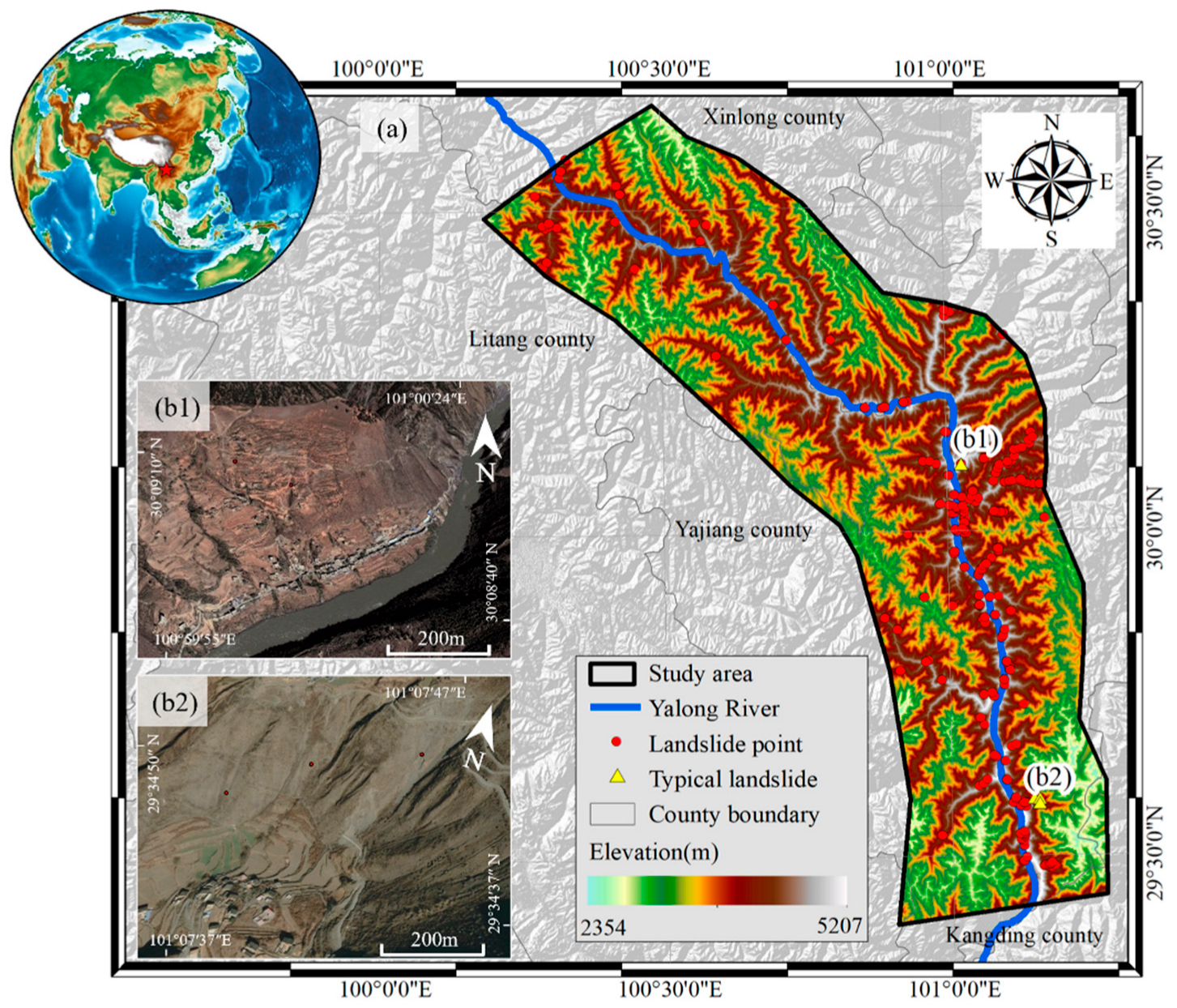
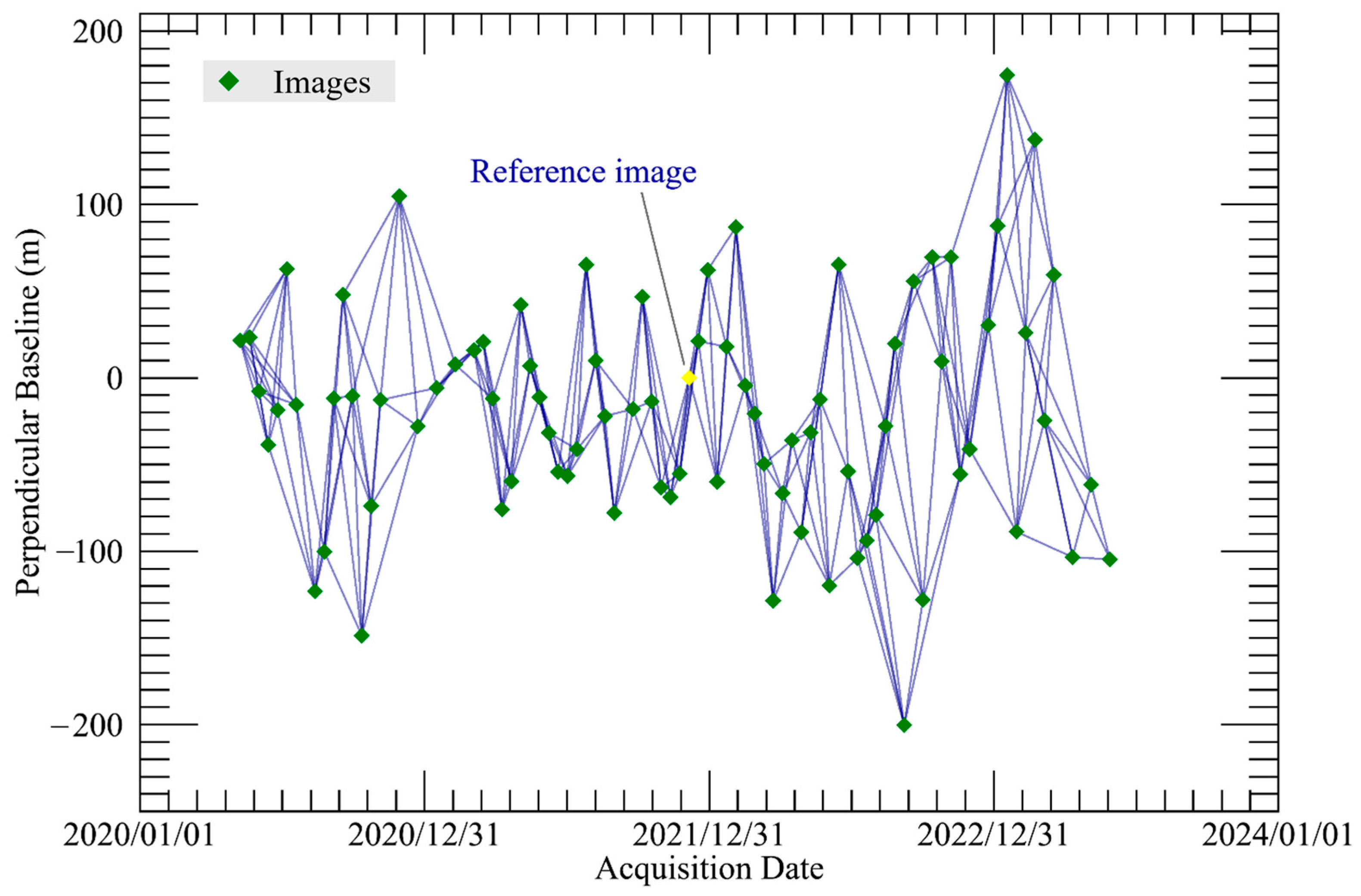
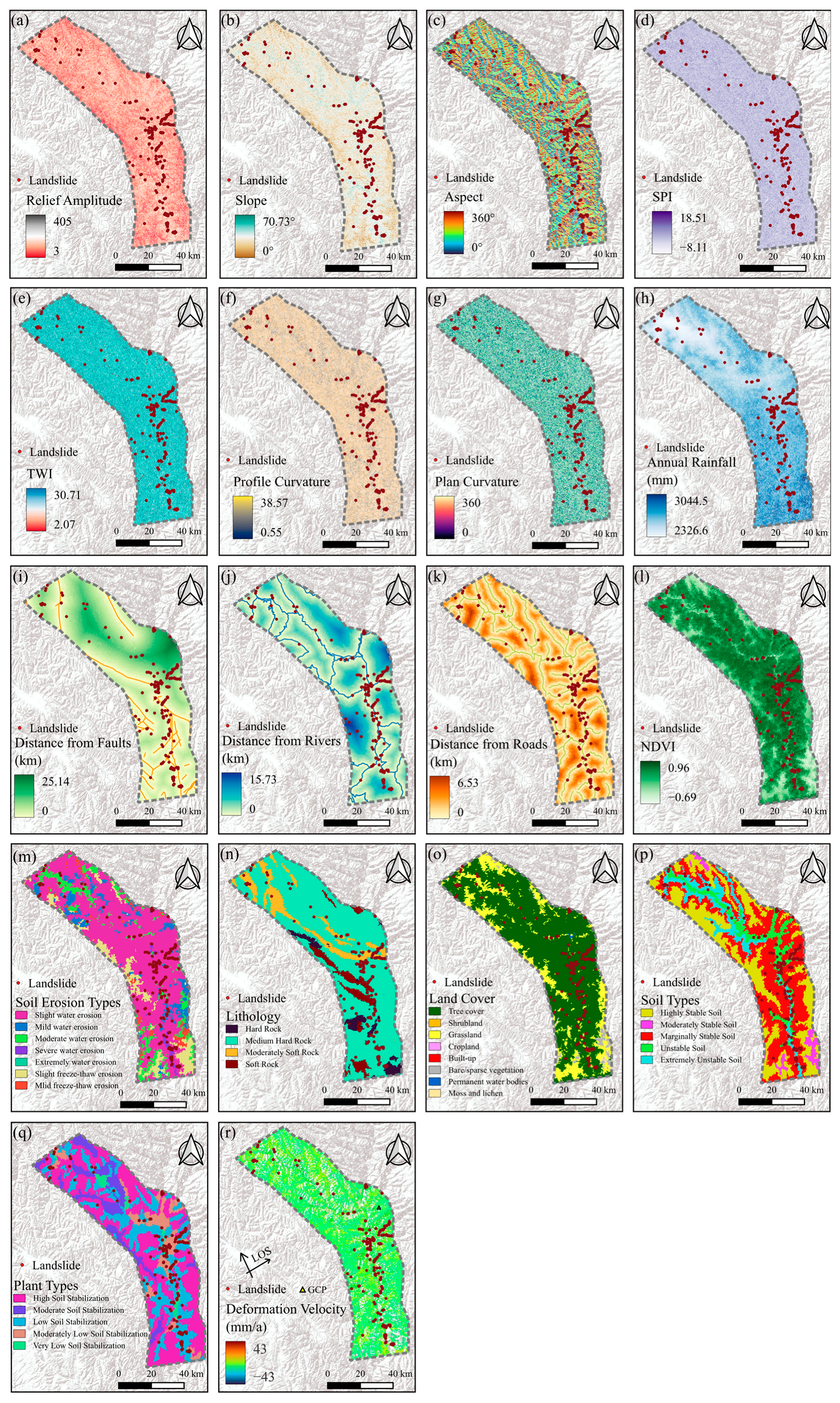


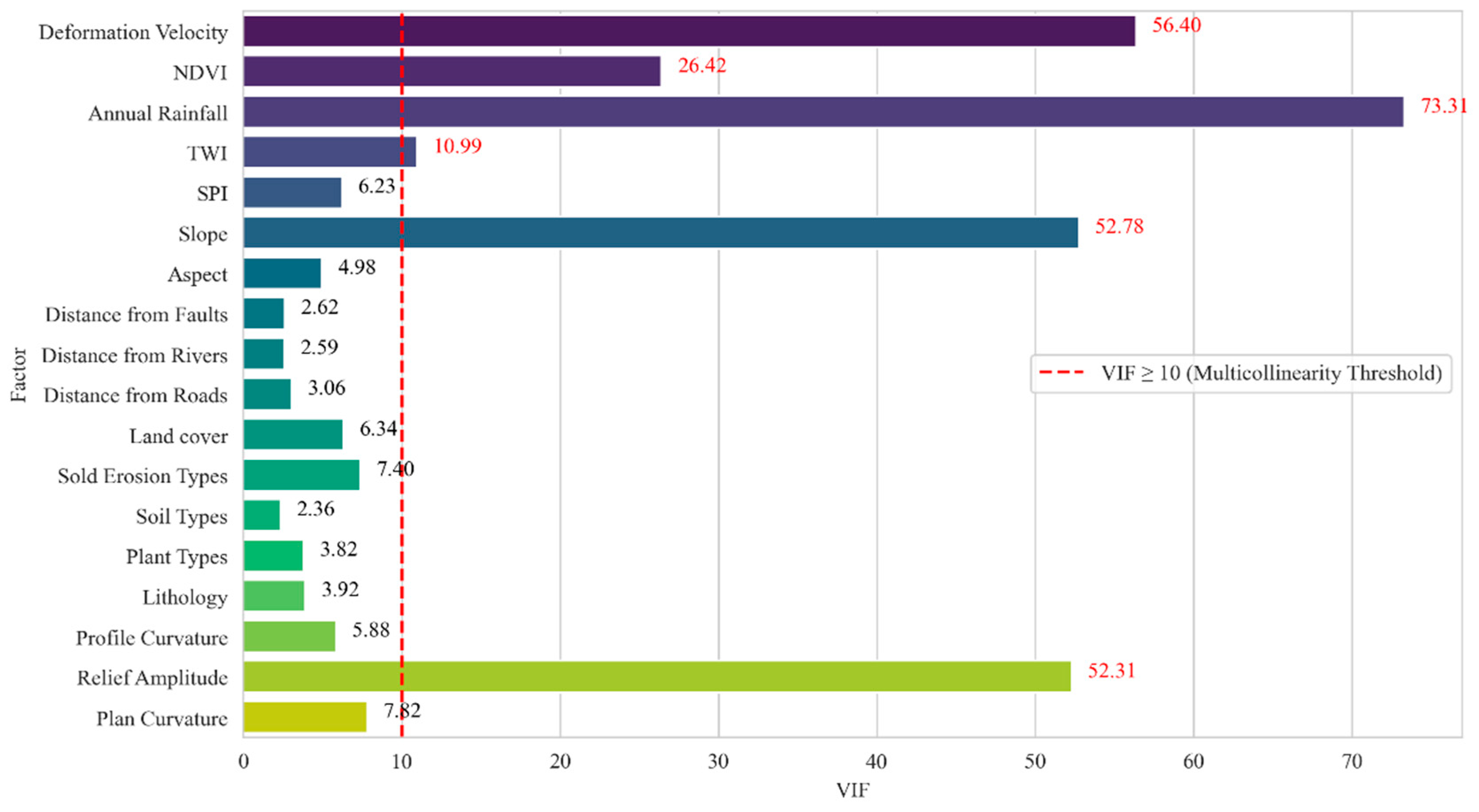
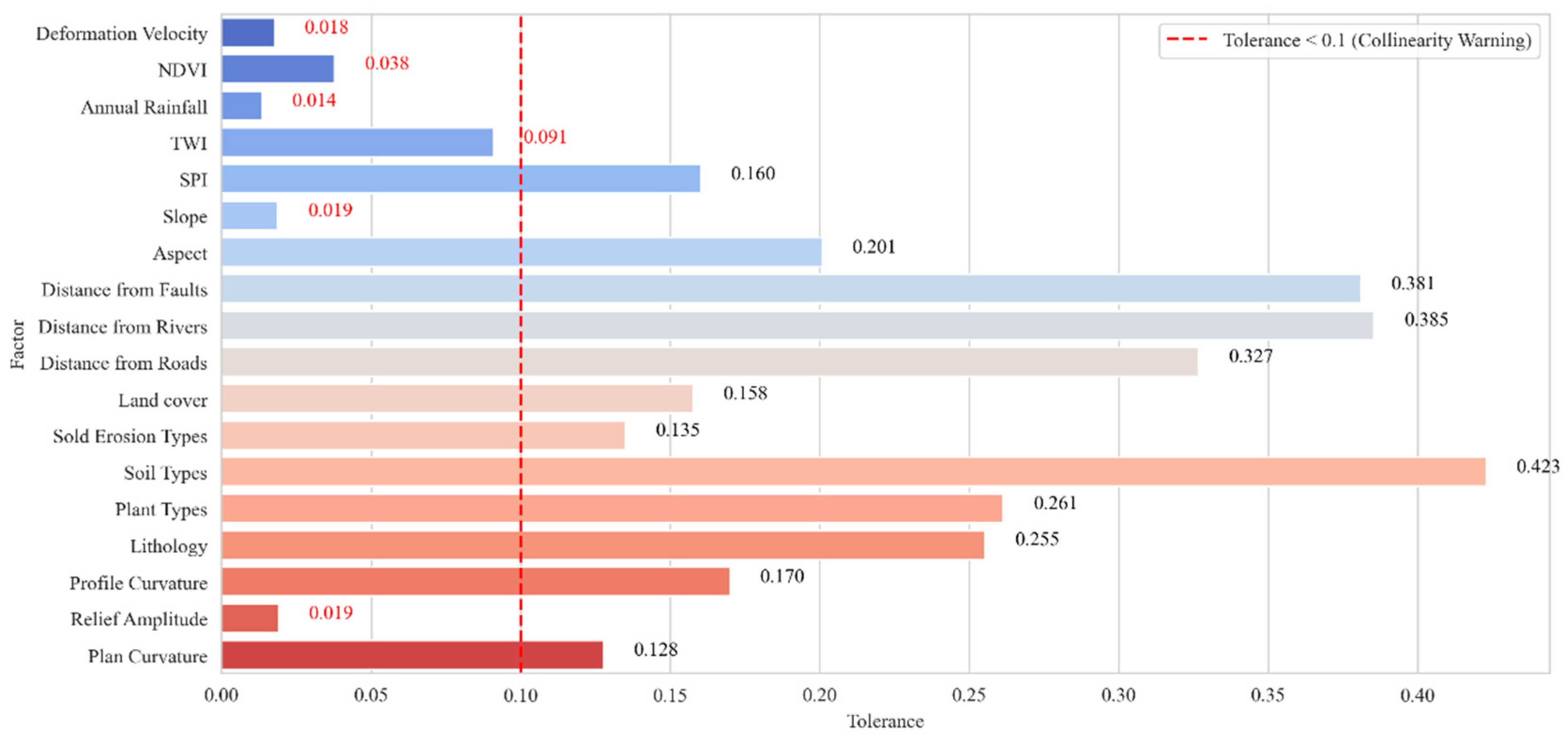
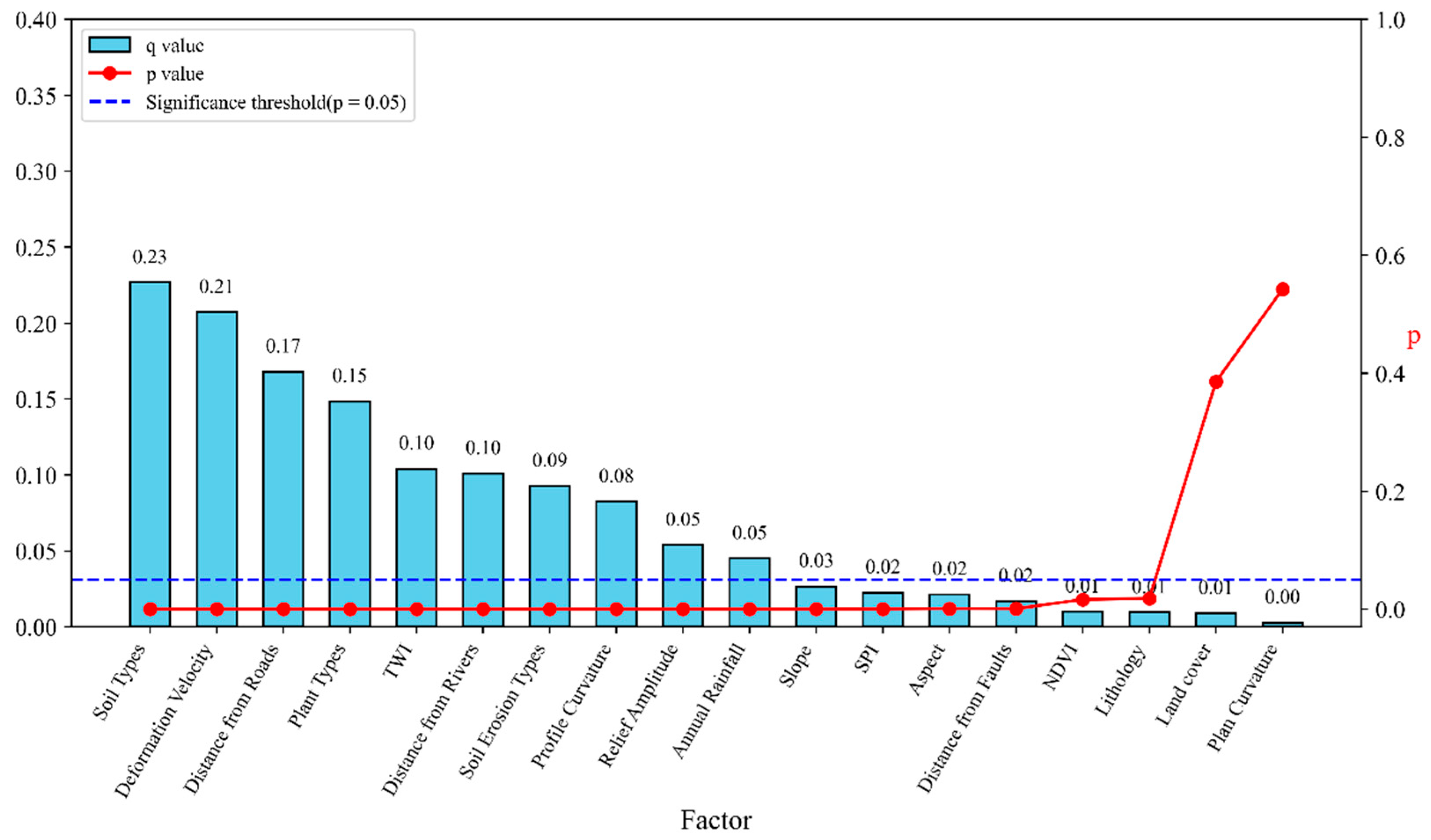
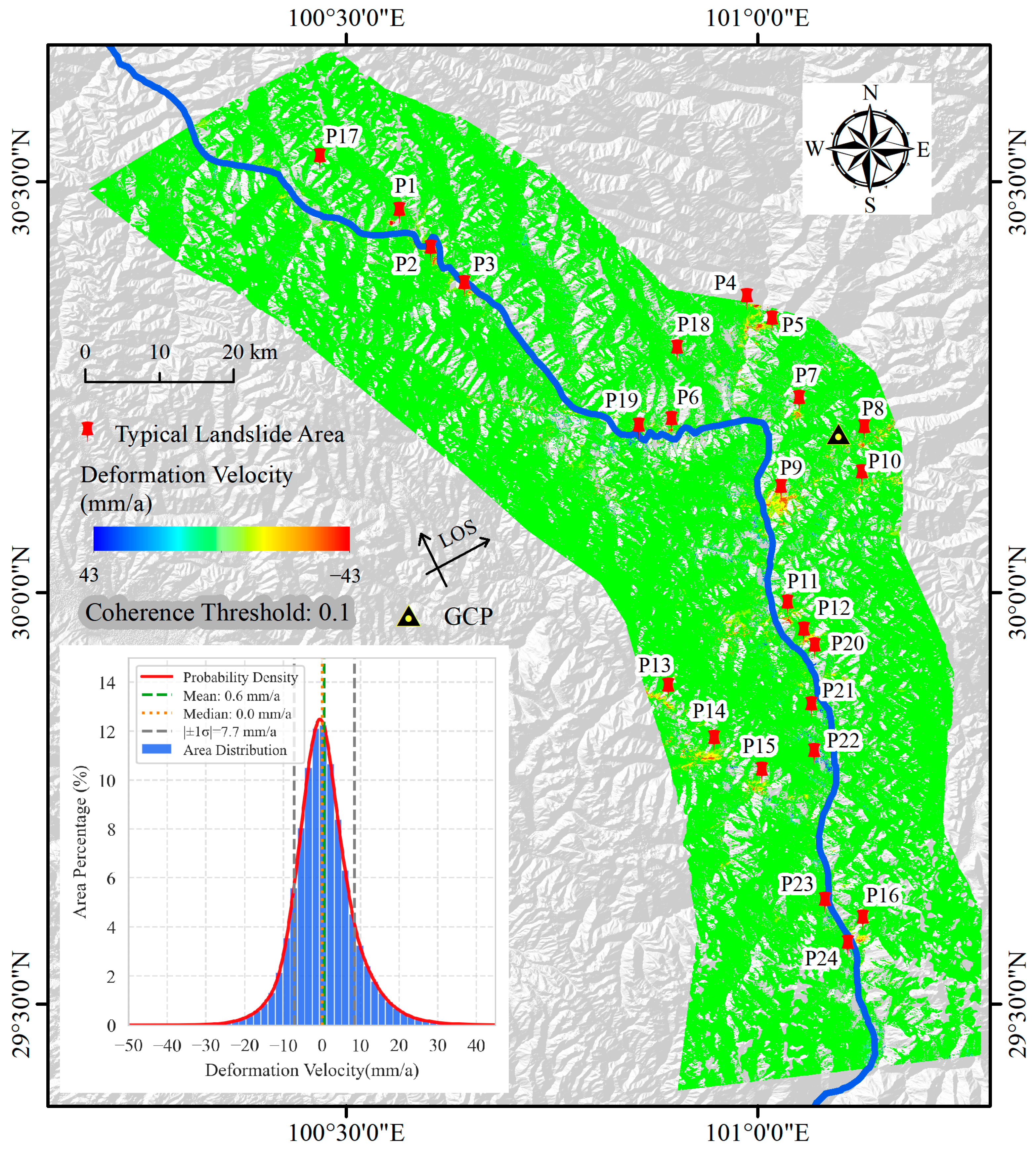
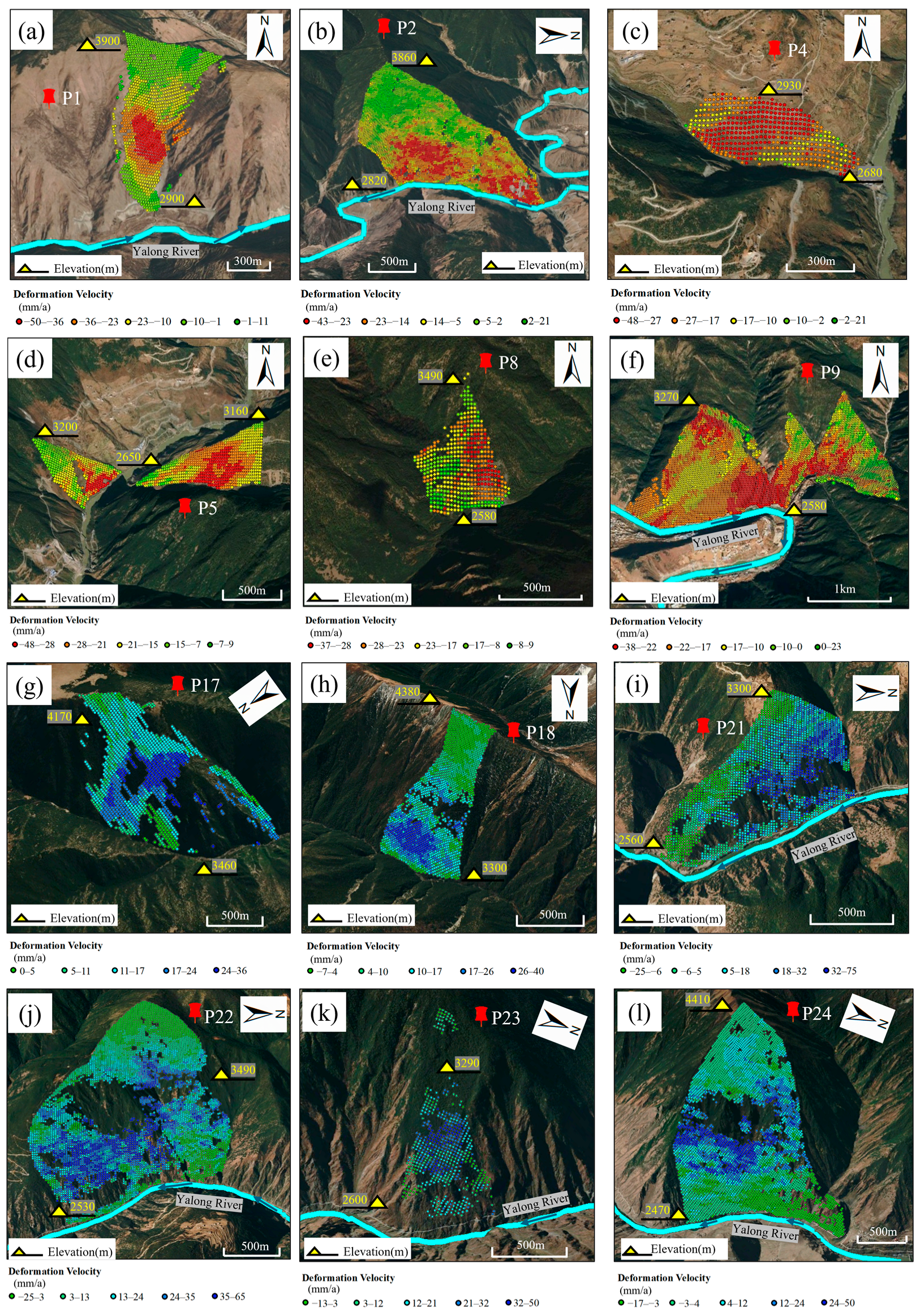
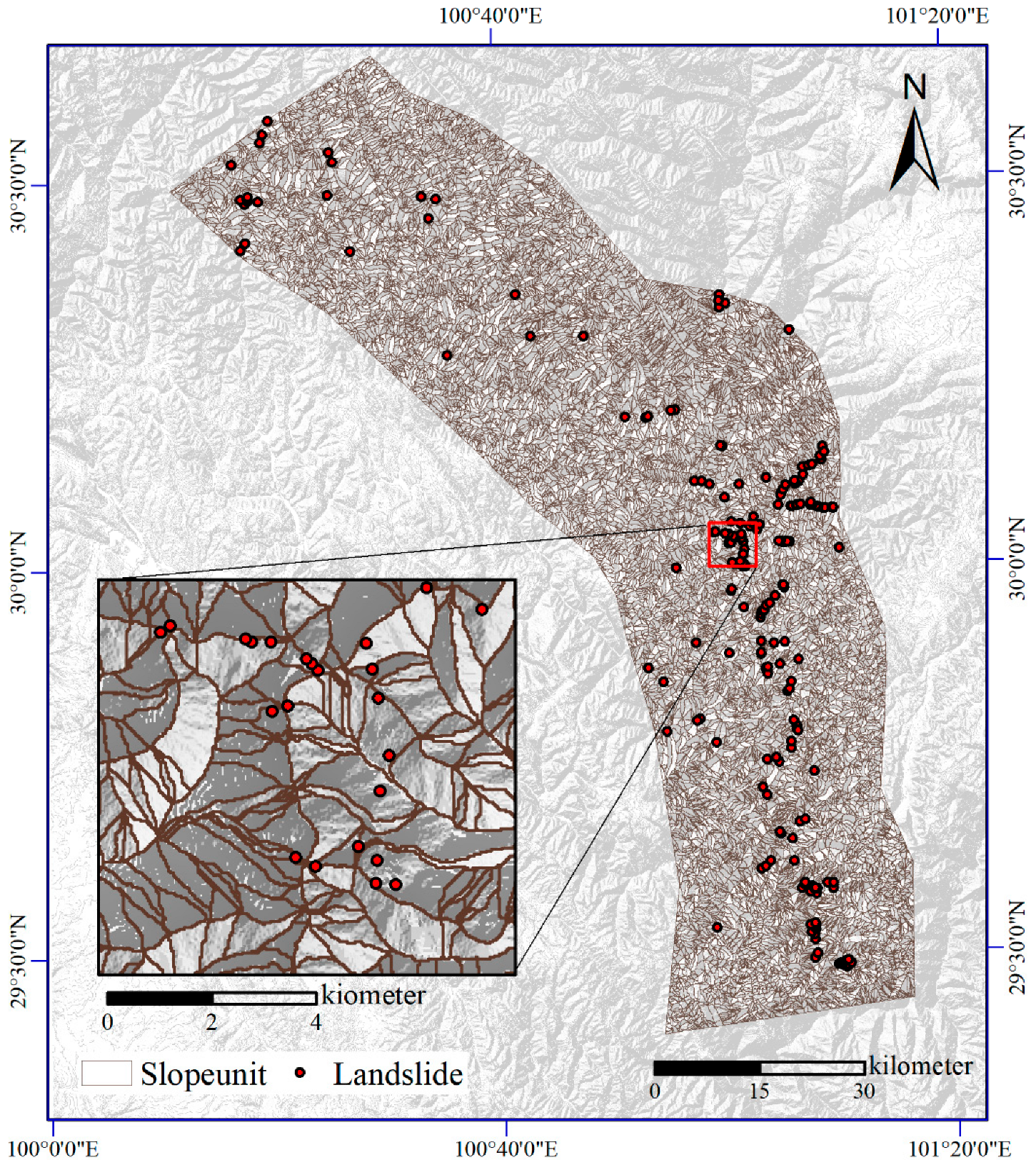
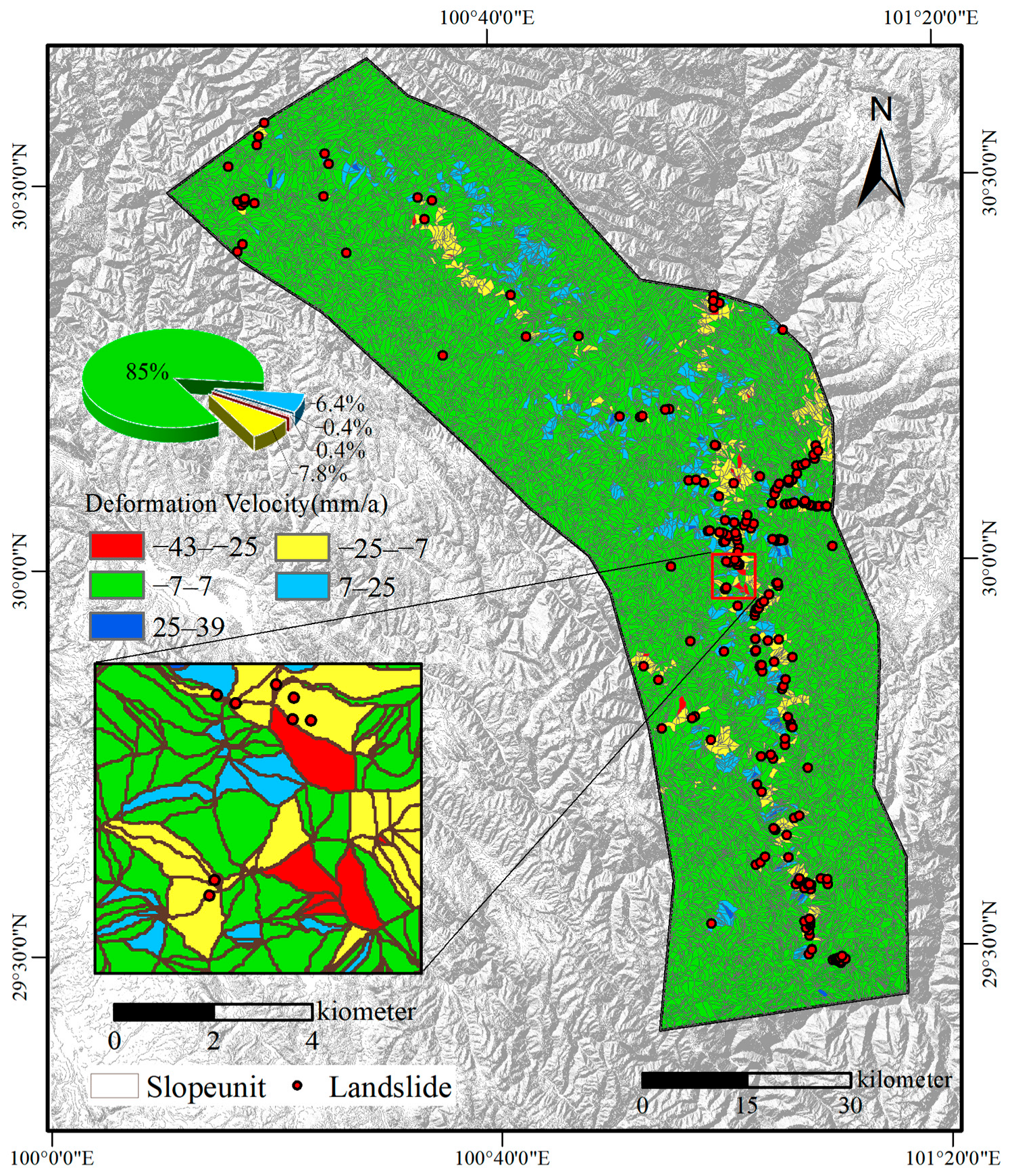
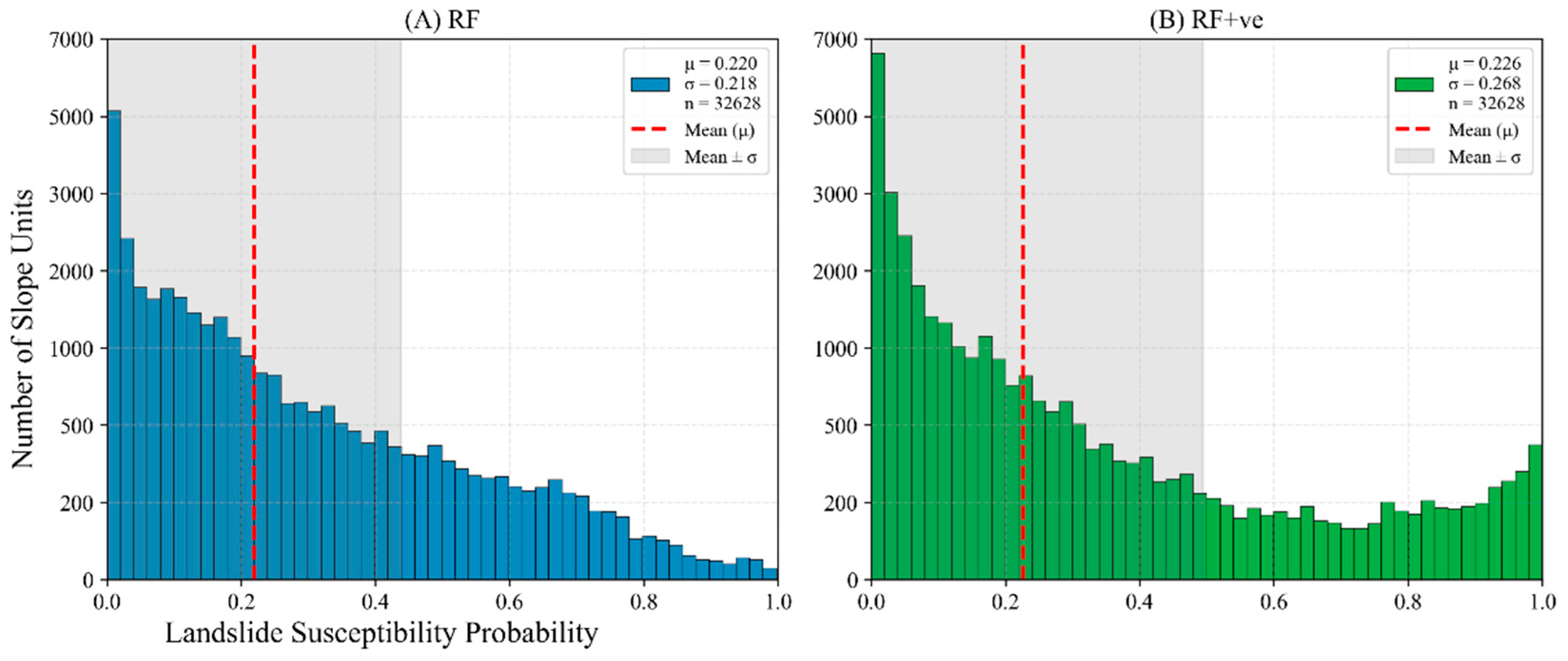
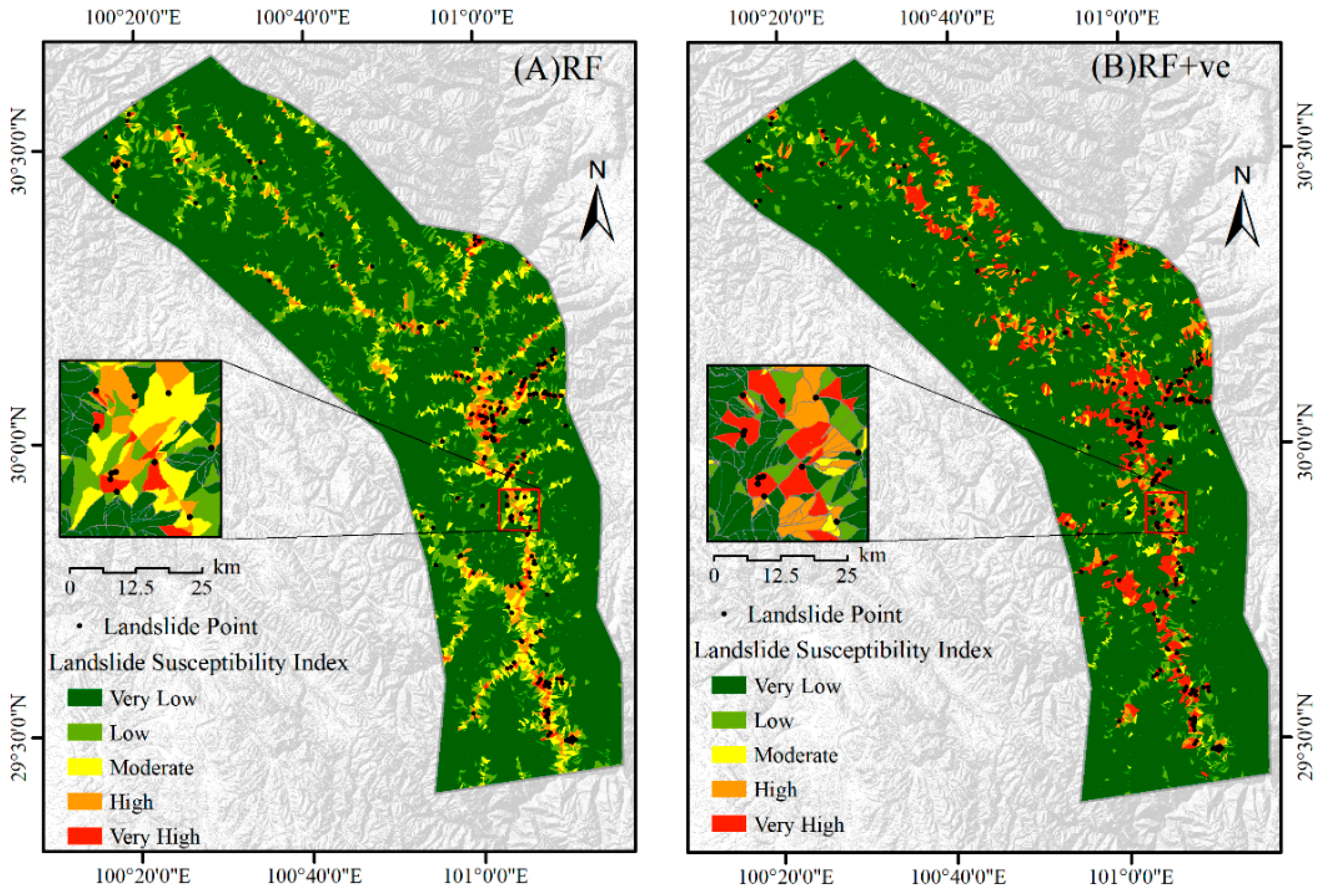
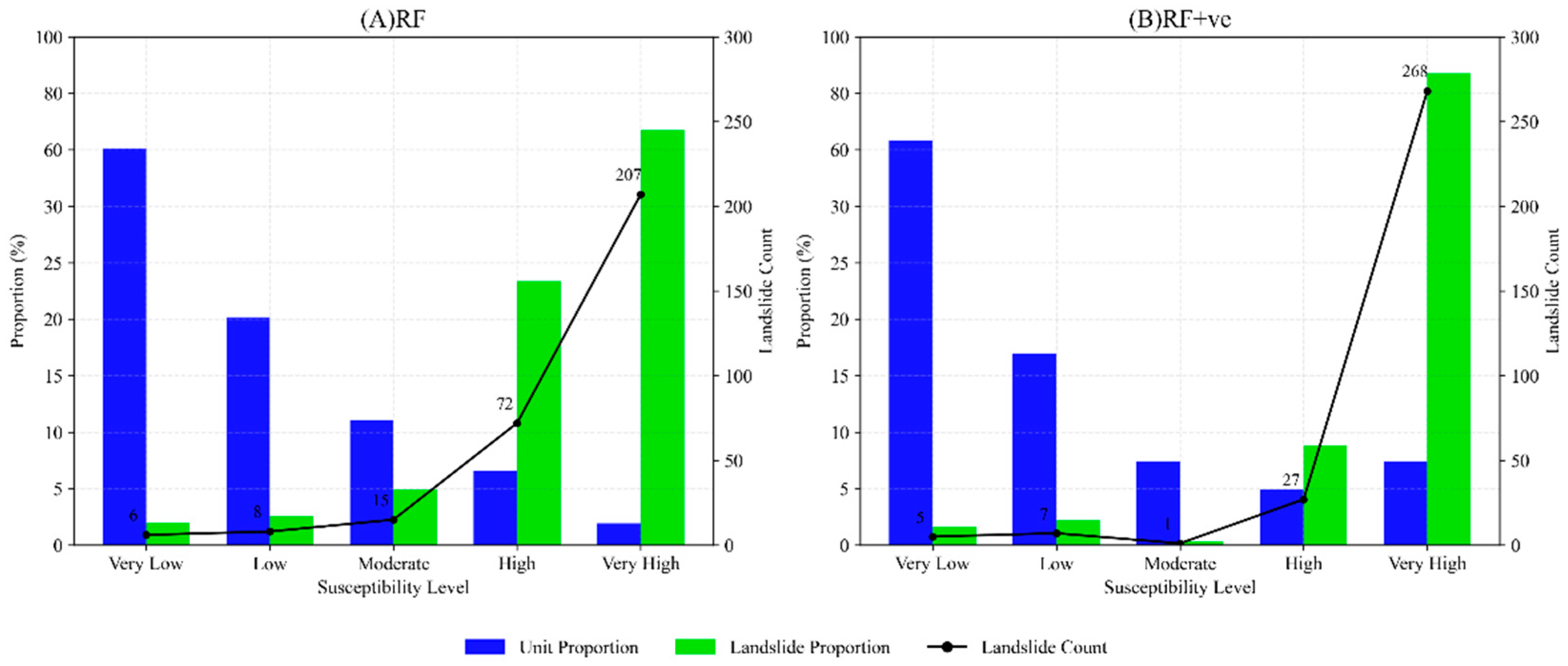
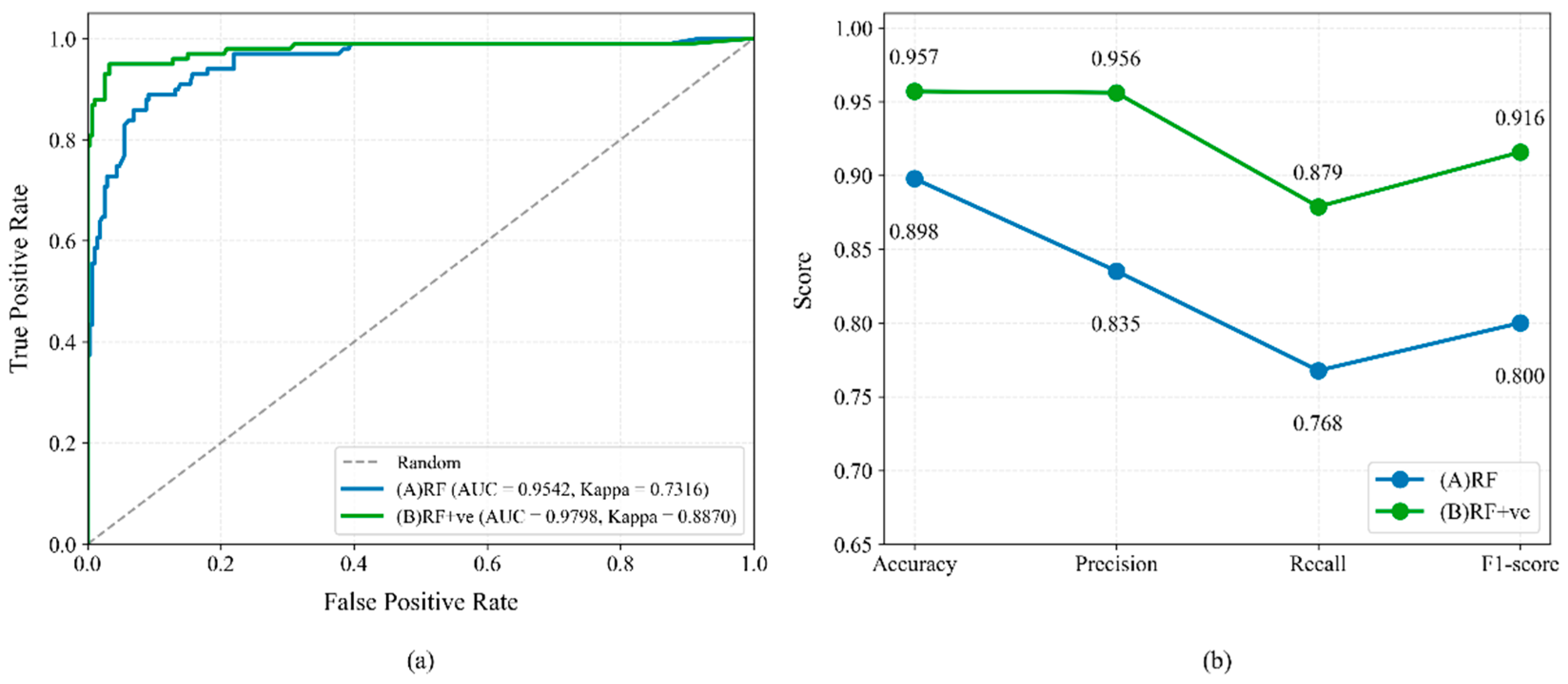
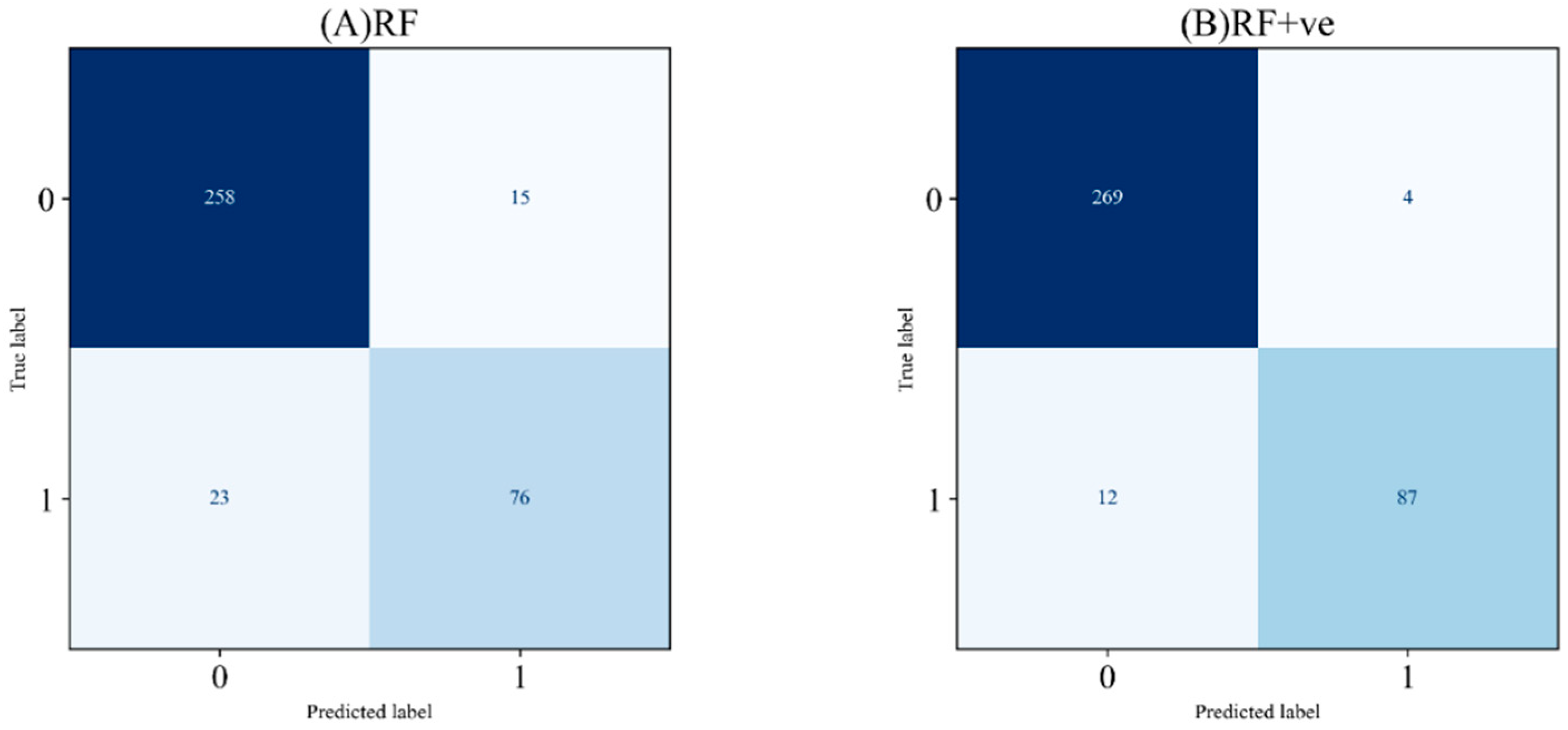
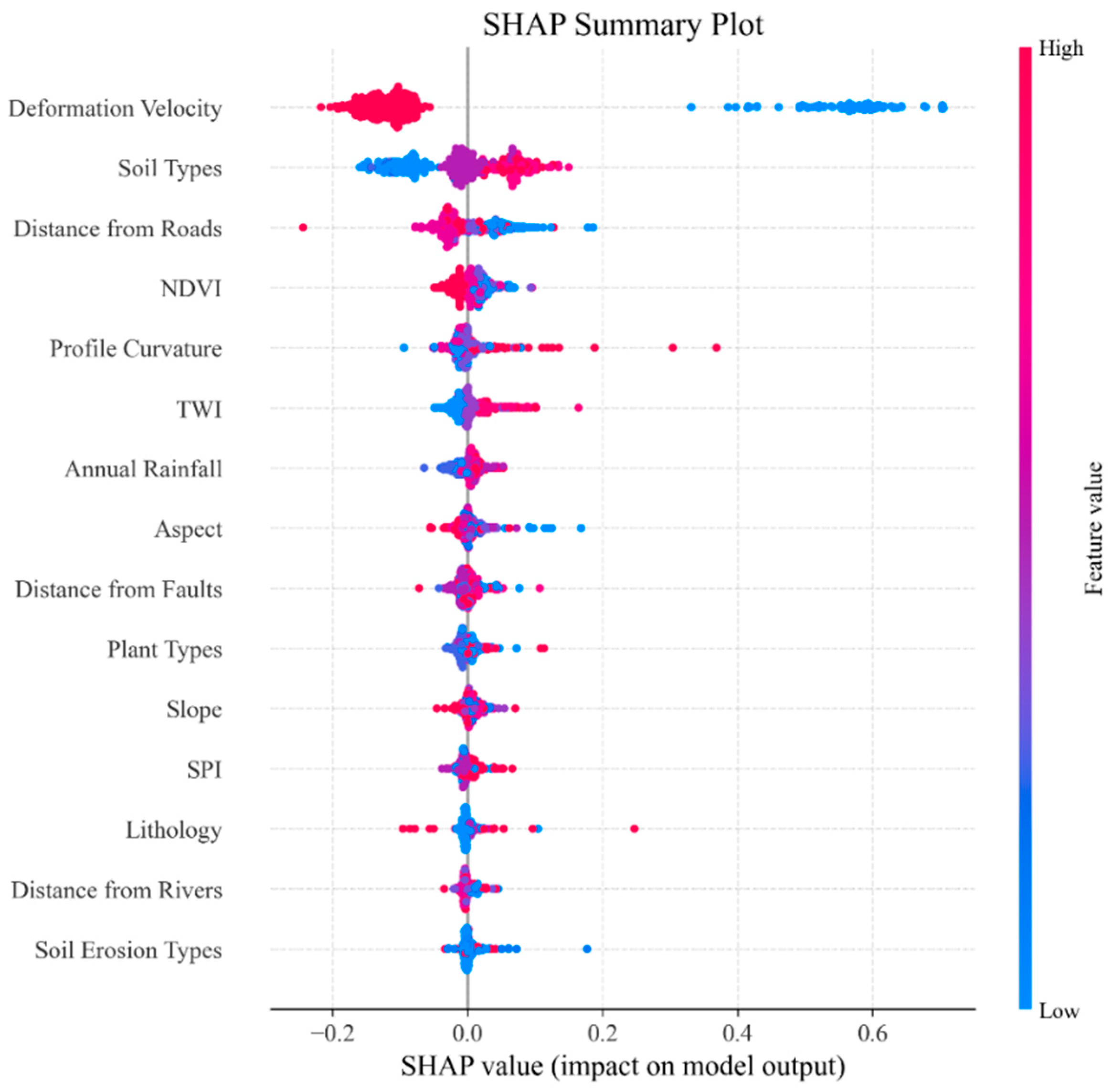
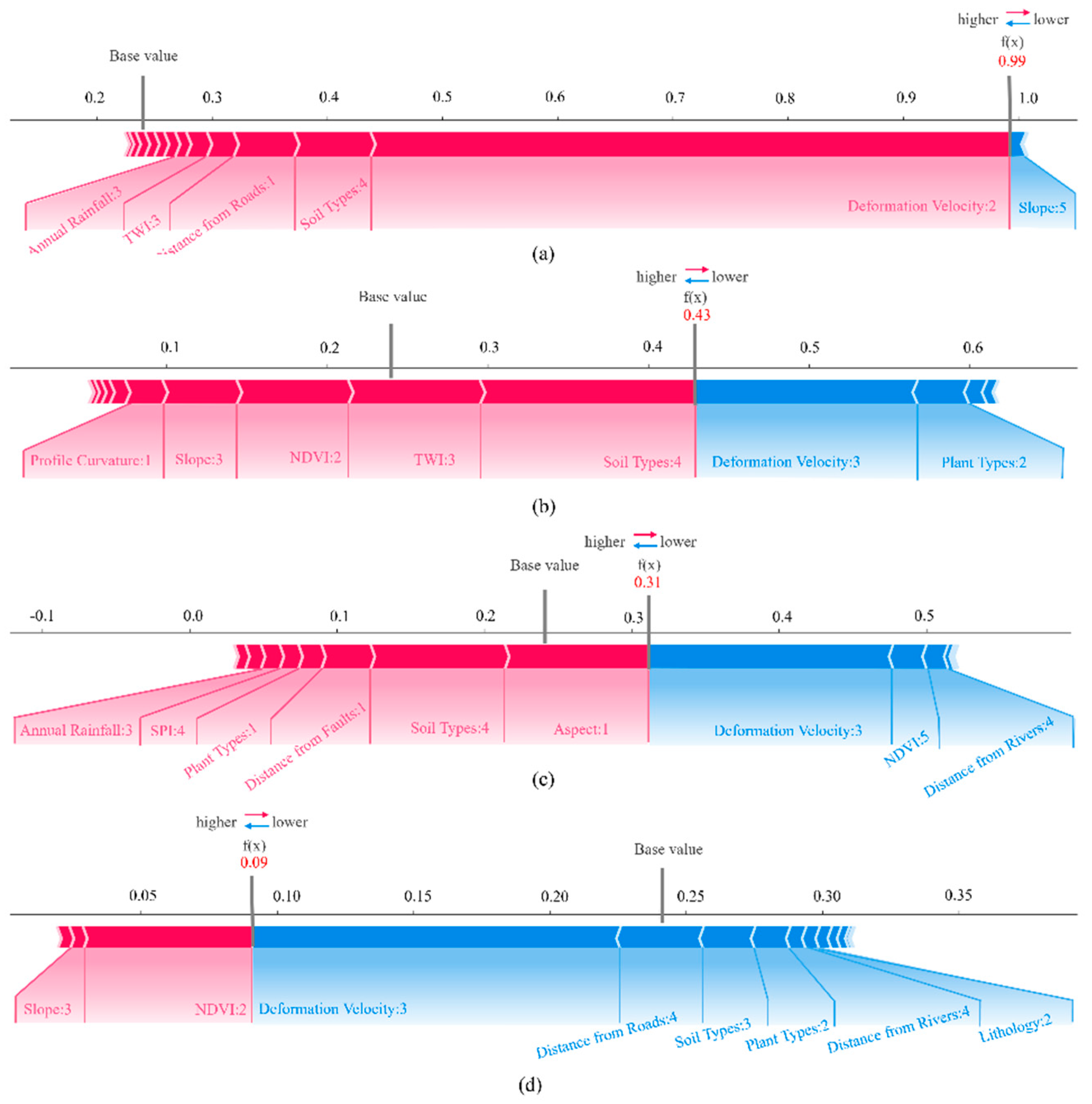
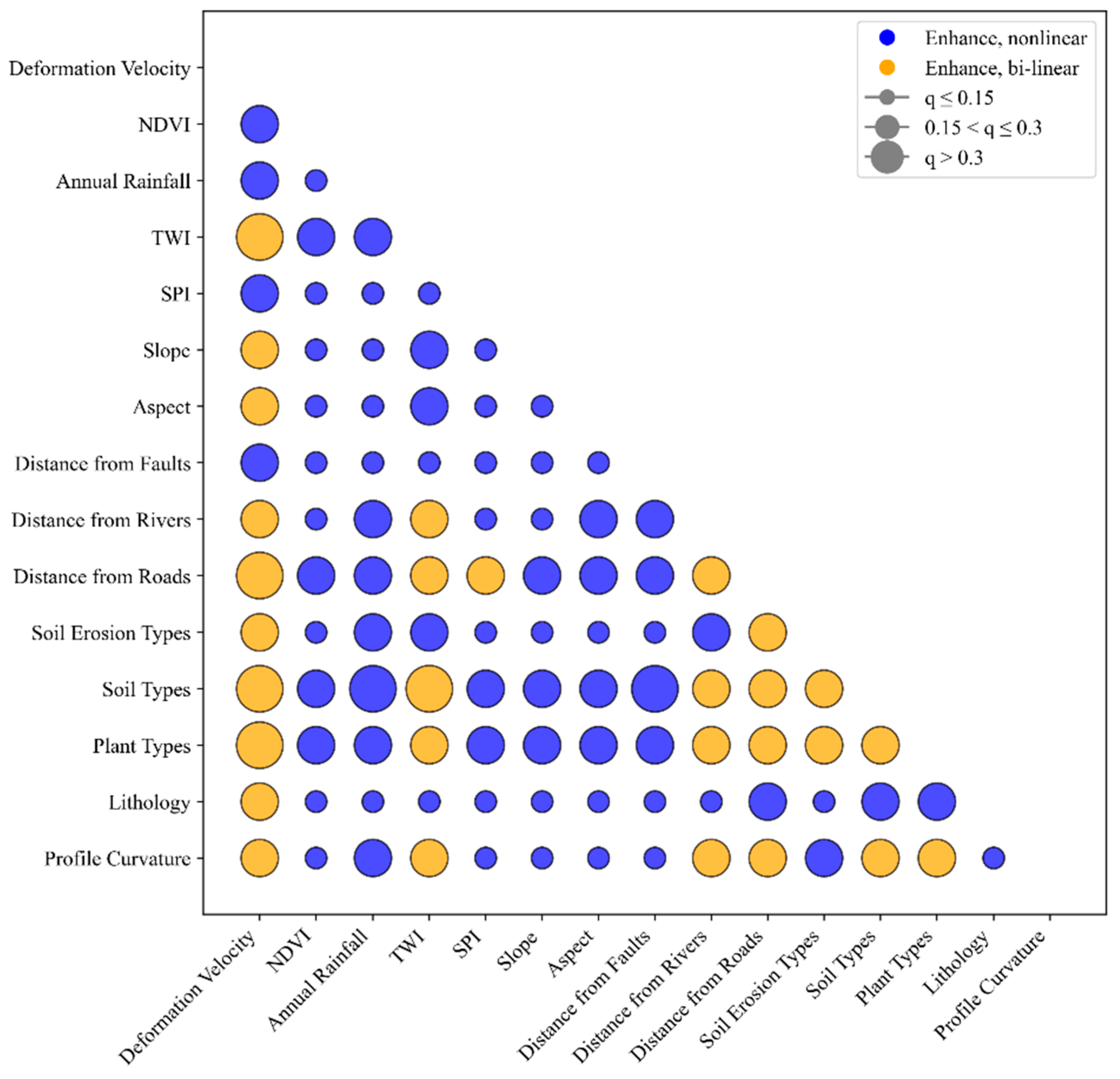
| Parameter | Sentinel-1 SAR Data |
|---|---|
| Orbit direction-Track Number | Ascending-26 |
| Radar band | C |
| Radar wavelength (cm) | 5.6 |
| Spatial resolution (m) | 20 |
| Incidence angle (°) | 34.35 |
| Revisit period (days) | 12 |
| Imaging mode | IW |
| Polarization mode | VV |
| Looks (Range: Azimuth) | 8:2 |
| Time span | May 2020–May 2023 (83 Images) |
| Data Name | Resolution/Scale | Source/Data Platform |
|---|---|---|
| SRTM DEM | 30 m | NASA Earth data Search |
| China 1 km Monthly Precipitation Dataset (1901–2023) | 1 km | [56] |
| National river and road vector data | 1:250,000 | National Geographic Information Catalog Service System (Ministry of Water Resources) |
| 1:200,000 Regional Geological Survey Map | 1:200,000 | China Geological Survey |
| ESA World Cover Land Use Dataset | 10 m | ESA World Cover Viewer |
| 1:1,000,000 Vegetation Atlas of China | 1:1,000,000 | National Glacier and Permafrost Desert Science Data Center |
| 1:1,000,000 Soil Map of the People’s Republic of China | 1:1,000,000 | Resources and Environmental Sciences Data Center |
| Landsat 8 Surface Reflectance Imagery | 30 m | USGS Earth Explorer |
Disclaimer/Publisher’s Note: The statements, opinions and data contained in all publications are solely those of the individual author(s) and contributor(s) and not of MDPI and/or the editor(s). MDPI and/or the editor(s) disclaim responsibility for any injury to people or property resulting from any ideas, methods, instructions or products referred to in the content. |
© 2025 by the authors. Licensee MDPI, Basel, Switzerland. This article is an open access article distributed under the terms and conditions of the Creative Commons Attribution (CC BY) license (https://creativecommons.org/licenses/by/4.0/).
Share and Cite
Li, Z.; Xiang, J.; Zhuo, G.; Zhang, H.; Dai, K.; Shi, X. Dynamic Landslide Susceptibility Assessment in the Yalong River Alpine Gorge Region Integrating InSAR-Derived Deformation Velocity. Remote Sens. 2025, 17, 3210. https://doi.org/10.3390/rs17183210
Li Z, Xiang J, Zhuo G, Zhang H, Dai K, Shi X. Dynamic Landslide Susceptibility Assessment in the Yalong River Alpine Gorge Region Integrating InSAR-Derived Deformation Velocity. Remote Sensing. 2025; 17(18):3210. https://doi.org/10.3390/rs17183210
Chicago/Turabian StyleLi, Zhoujiang, Jianming Xiang, Guanchen Zhuo, Hongyuan Zhang, Keren Dai, and Xianlin Shi. 2025. "Dynamic Landslide Susceptibility Assessment in the Yalong River Alpine Gorge Region Integrating InSAR-Derived Deformation Velocity" Remote Sensing 17, no. 18: 3210. https://doi.org/10.3390/rs17183210
APA StyleLi, Z., Xiang, J., Zhuo, G., Zhang, H., Dai, K., & Shi, X. (2025). Dynamic Landslide Susceptibility Assessment in the Yalong River Alpine Gorge Region Integrating InSAR-Derived Deformation Velocity. Remote Sensing, 17(18), 3210. https://doi.org/10.3390/rs17183210







